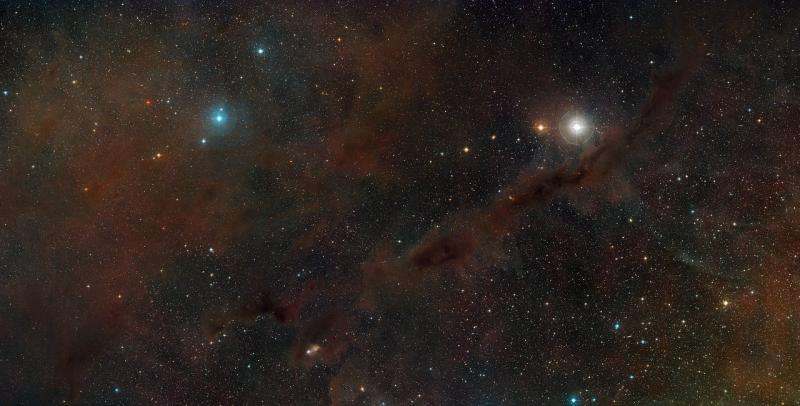Constraining the chemistry of carbon-chain molecules in space

The interstellar medium of the Milky Way contains 5-10% of the total mass of the galaxy (excluding its dark matter) and consists primarily of hydrogen gas. There are small but important contributions from other gases as well, including carbon-bearing molecules both simple, like carbon monoxide and carbon dioxide, and complex like ethene, benzene, propynal, methanol and other alcohols, and cyanides. There are even some very large molecules like polycyclic aromatic hydrocarbons and buckyballs with fifty or more carbon atoms. Some species like the cyanides have relative abundances similar to what is seen in comets in our solar system, suggesting that local carbon chemistry is not unique.
Astronomers think complex interstellar molecules are probably produced on dust grains, although some molecules might be produced in the gas phase. About one percent by mass of the interstellar material, these tiny grains are composed predominantly of silicates and provide the gas molecules with surfaces on which to react with other molecules. Carbon chain molecules are particularly interesting because they are thought to be the starting point for a significant fraction of the known complex chemicals in the interstellar medium. It is even suspected that carbon-chain species are a key stage in the formation of polycyclic aromatic hydrocarbons. Carbon-chain molecular chemistry thus provides insight into a large subset of interstellar chemistry.
A particularly well-studied family of carbon chains is the cyanopolyynes: linear molecules of the form HCnN, where n = 3, 5, 7, 9, etc. They have been observed in high abundance towards older stars and in cold dark clouds. The presence of the largest known cyanopolyyne, HC11N, however, is in dispute. It was reportedly detected in 1982 towards one dark cloud in Taurus, but that detection has not been confirmed. CfA astronomers Ryan Loomis and Brett McGuire and their colleagues used the Green Bank Telescope to search the Taurus region for HC11N in six of its characteristic radio wavelength transitions, including the two in which it was first reported, but without success.
The astronomers argue that the previous detection was an error, and they offer an explanation for the otherwise curious absence of the n=11 species. Laboratory experiments have shown that when carbon-chain molecules get to be longer than about n=9 they begin to curl on themselves and preferentially transform into carbon-ring molecules, which are more stable. A similar process could be occurring in the interstellar medium, siphoning away HC11N to form cyclic species. The non-detection of HC11N thus suggests the importance of this chemical pathway in producing cyclic molecules, although the authors note that further observations and laboratory experiments are needed to confirm the model.
More information: Ryan A. Loomis et al. Non-detection of HCN towards TMC-1: constraining the chemistry of large carbon-chain molecules, Monthly Notices of the Royal Astronomical Society (2016). DOI: 10.1093/mnras/stw2302
Journal information: Monthly Notices of the Royal Astronomical Society
Provided by Harvard-Smithsonian Center for Astrophysics


















